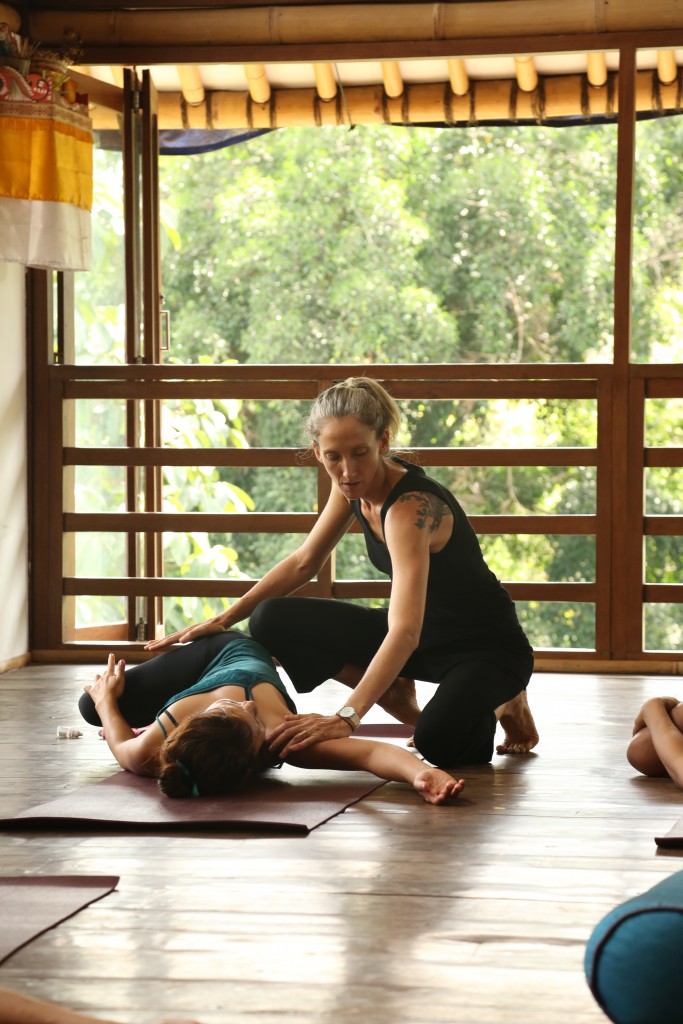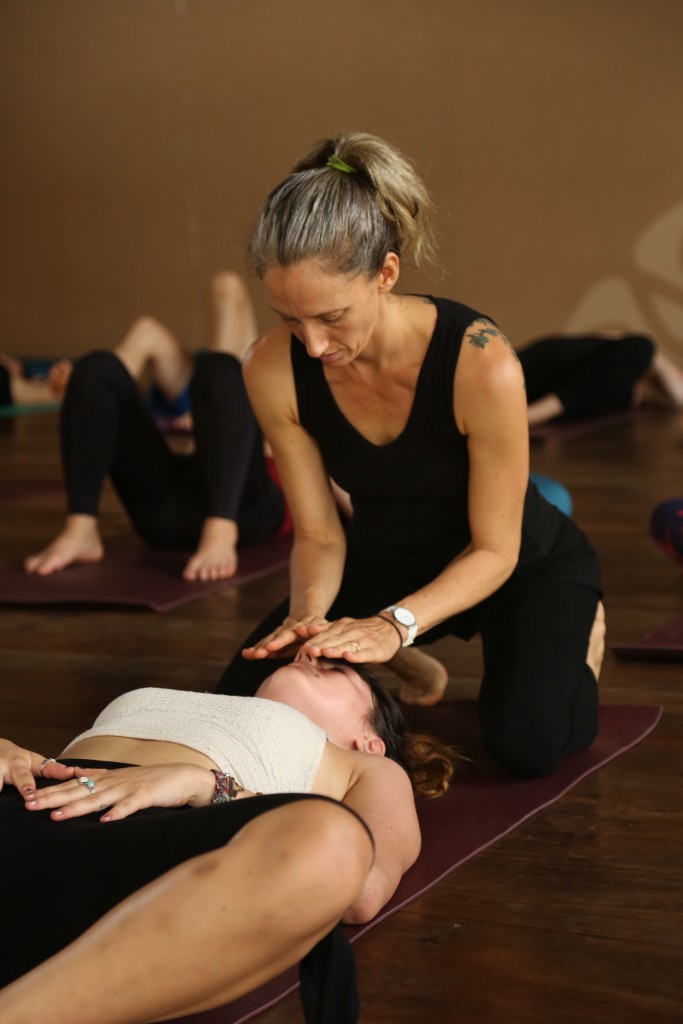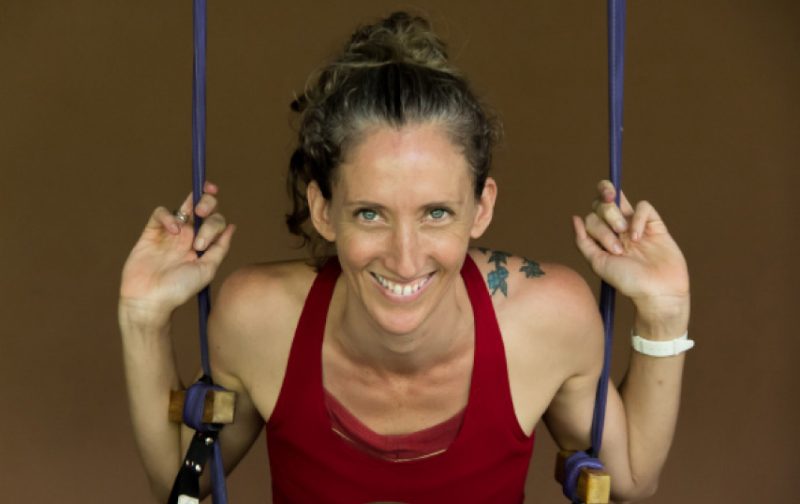Teaching restorative yoga can be tricky as often practitioners are dealing with injuries and fragile conditions. They trust the teacher’s professionalism and experience to lead them through a safe practice with the hope of improvement and/or recovery. Having a few aches and pains myself, and believing that the body can heal itself (to a certain level), makes me constantly research the ‘hows’ and ‘whys’ of our body’s mechanics, and what part the mind plays.

Our brain controls our physical body, and often our mental and emotional state – it is kind-of bossy. It is very important for our body to immediately obey the orders from our Bouncy Castle brain without hesitation or questioning otherwise we couldn’t function properly. However, it is also important to train the brain to be less controlling and more receptive. So how do we get it to stop talking and start listening?
Much like political leaders, corporate CEOs, controlling parents or compulsive partners, some of the people used to giving orders are not very good listeners. Especially when something goes wrong – like a malfunction in a factory or, in this case, a physical injury, they don’t always agree to take responsibility. Because of our natural defense mechanism we might trace back our injury to an inexperienced yoga teacher who made us do something wrong, or to a friend who pushed us to go too far. In most cases, if we were to put our ego aside and listen to the reality of our body’s abilities, we would stay injury-free for a lifetime of practice.
It’s hard to move our ego aside, but that’s when healing starts.
We need to look for the right moment, when the “control manager” is relaxed and receptive. Then try to communicate slowly, with a very specific emphasis on the important bit, and repeat to yourself more than once in order for the message to go through. This way, we can not only treat and heal our injuries and pains, but also prevent them. Giving our body (and our parents, kids and colleagues or employees) the feeling that we are listening and learning is priceless. It is guaranteed to transform the relationships you’re in.
It’s kind of simple: think first, then choose the focus. Then stop and listen. Allow slow, repetitive movement to lead you through the simplest of motions, and you’ll establish a safe and healthy system that will effect you in every aspect of life.
That is how I practice and teach restorative yoga. Combining basics from Iyengar yoga with Feldenkrais and Alexander techniques, inspired by Hanna Somatics movement, it’s mainly done laying down. Eyes closed. Body moves so little and so slow, that after a while you realise that the brain, the big boss, has slowed down and started to listen, receive and heal. You’re deeply relaxed and half asleep. One movement happens only in one body part, one joint, and the information of how this joint moves flows to the brain rather than from it. Understanding happens from deep inside, not forced upon from the top.
 You may notice that the brain is trying to take over by labeling your sensations. Don’t let it, as this is non-verbal conversation. We may speak English, Chinese or French both inside and outside our head, but our physical body doesn’t need words. Those will just restrict what we feel into the narrow realm of… yes, our brain. Our muscles, bones and connective tissues have their own sensor-motoric language. It’s like, when a child sees an object for the first time, it can be a million things. The child’s creativity and imagination are limitless. Naming the object is, on the one hand, essential for us to eventually function in society, but on a very basic level, it’s also a restriction. In a similar way, by saying our hip feels ‘soft’ or ‘open’ or ‘tight’ is useful if we communicate to someone else, but it takes us away from being with the simple feelings and sensations in our body.
You may notice that the brain is trying to take over by labeling your sensations. Don’t let it, as this is non-verbal conversation. We may speak English, Chinese or French both inside and outside our head, but our physical body doesn’t need words. Those will just restrict what we feel into the narrow realm of… yes, our brain. Our muscles, bones and connective tissues have their own sensor-motoric language. It’s like, when a child sees an object for the first time, it can be a million things. The child’s creativity and imagination are limitless. Naming the object is, on the one hand, essential for us to eventually function in society, but on a very basic level, it’s also a restriction. In a similar way, by saying our hip feels ‘soft’ or ‘open’ or ‘tight’ is useful if we communicate to someone else, but it takes us away from being with the simple feelings and sensations in our body.
On that note, while we move in this restorative manner, which you’ll get a taste of at the end of this article, we may find something new. But we don’t know what it is, which makes the search much more open and genuine than a search with a fixed result. It may be hard to get the mindset of looking for the unknown, but that is another step towards the idea that the brain can sit back, relax and listen.
I’ve had some students who found the reason for an ongoing pain. Some found a better alignment for their hip or shoulders. And some found the ending for the book they’ve been writing or the theme for their next art exhibition. Answers come when you least expect them, when we are distracted, when we reduce speed.
Slow down your next meal. Your shower. Take time to listen when people talk to you instead of just thinking of your reply. Take some time to enjoy the view from your bed, even if it’s only of the wall. Slow down your transition from upward facing dog to downward facing dog. Enjoy the time you spend in triangle pose instead of rushing out of it.
It’s when we move fast we get injured. When we eat fast we eat too much. When we talk fast we regret something we said. So slow down, and you’ve already done something good for this planet. This fast moving, harmful and destructive world.
A segment of the practice for you to try at home:
Lie on your back, right knee bent, foot flat on the floor. Left leg is straight and relaxed.
Keep the right foot in full contact with the mat as you start to slowly turn the right knee and leg towards the right side. Don’t allow the inner side of your foot to lift up.
When it can’t move any more to the side, slowly bring your right leg back to center and start moving it towards the opposite direction. Keep the foot in full contact with the mat.
Return to the starting point and repeat a few more times. Keep slowing yourself down and notice how the “auto pilot” likes to take over and speed things up.
Before doing the other side, take a moment lying down flat on your back. Give time for the different sensations to be fully present in your body. Notice if you’re eager to do the other side straight away, and give some time just for the imbalances to recede.
You can do the right leg again first, this time allowing the sole of the foot to detach from the mat as you turn the leg away from the midline.
Than repeat with the left leg.
Be gentle and keep listening to what is going on inside.
Just like any other practice, it takes devotion, dedication and belief. The more often practiced, the better understanding you get. This is a very internal practice. Connecting to nothing but your inner self is also quite meditative, opening the doors to the realm of self-exploration and mindful awareness.
But that’s another story… More about meditation, its benefits and challenges will have to be discussed another time. For now- just get down and try this version of restorative yoga. Beware, it’s addictive!
Remember that like other doors, when this one is open, and you walk in, you will never be the same again.
……………………………………………………….
Biography
Noga is a passionate Yoga teacher. She has a gift in making everyone fall in love with Yoga, offering her students the perfect challenge to keep them growing in their practice. She teaches regularly at Radiantly Alive Yoga Studio in Ubud, Bali. Her website: noga-yoga.com or Facebook: noga-yoga bali.com
To read the full article please download our Asana Journal App or purchase Issue 155 Nov 2015.




















 Other
Other